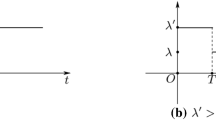Abstract
An inventory system is operated as a base stock system under a compound Poisson demand process. Besides having inventory and backorder costs, also a cost is incurred for each order that is delivered in several pieces to the customer (irrespective of whether some items in the order are delivered on time, or whether they are all delivered late but at different times). The possible split deliveries are assumed to happen automatically, meaning that there cannot at the same time be a positive on-hand inventory and a positive backlog. We develop a mathematical cost expression for this system to be optimized, denoted Model 1. We compare Model 1 to another model, denoted Model 2, where it is forbidden to make any of these split deliveries; thus at the same time, there can be a positive on-hand inventory and a positive backlog. We compare Model 2 to the standard textbook model, denoted Model 0, where split deliveries occur automatically and are costless. Thereby, we address a claim made by Zipkin (Foundations of inventory management. McGraw-Hill, Boston, 2000). We also examine the threshold value for the delivery split cost, which makes Model 1 and 2 perform equally well, and we examine how this threshold value depends on the other common parameters of the models.
Similar content being viewed by others
References
Adelson RM (1966) Compound Poisson distributions. Op Res Q 17:73–75
Axsäter S (1990) Simple solution procedures for a class of two-echelon inventory problems. Op Res 38:64–69
Axsäter S (2006) Inventory control, 2nd edn. Springer, New York
Axsäter S, Zhang W-F (1996) Recursive evaluations of order-up-to-S policies for two-echelon inventory systems with compound Poisson demand. Nav Res Log 43:151–157
Forsberg R (1995) Optimization of order-up-to-S policies for two-level inventory systems with compound Poisson demand. Eur J Oper Res 81:143–153
Kelton W, Sadowski R, Sturrock D (2007) Simulation with arena, 4th edn. McGraw Hill, Boston
Larsen C, Thorstenson A (2008) A comparison between the order and the volume fill rate for a base-stock inventory control system under a compound renewal demand process. J Oper Res Soc 59:798–804
Larsen C, Thorstenson A (2014) The order and volume fill rates in inventory control systems. Int J Prod Econ 147:13–19
Supply Chain Council (2010) SCOR overview, version 10. http://cloud.ld.ttu.ee/idu0010/Portals/0/Harjutustunnid/SCOR10.pdf. Accessed 20 June 2016
Zipkin P (2000) Foundations of inventory management. McGraw-Hill, Boston
Author information
Authors and Affiliations
Corresponding author
Appendix
Appendix
Denote by \(P_r^n \) the probability that demand unit number r occurring before the considered-order is contained in customer order number n occurring before the considered-order. It holds, see also Axsäter and Zhang (1996), that (the probability is zero for all other combinations of (r, n) than listed below)
For any n \(\ge \) 1 denote by the random variable T(n) the time interval from the arrival of the considered-order until order number n, occurring before the considered-order, arrived. It is an n-phased Erlang distribution with mean n/ \(\lambda \). The cumulative distribution function of W(r) is for any r \(\ge \) 1 given as (see also Axsäter and Zhang 1996)
Therefore,
We have
For r>1, we have
By collecting terms, (A5) can be rewritten as the lower half of (4).
From (A2), we also get that
The loss function of the Erlang distribution is, see also Axsäter and Zhang (1996),
In the case \(n = 1\), we have from (A7)
When n>1, we get from (A7)
It holds that
When r>1, we can similarly, as for derivation in (A5), rewrite \(E\left[ {W(r)-L} \right] ^{+}\) to
By collecting terms and using (A10), we can rewrite (A11) to the lower half of (5).
Rights and permissions
About this article
Cite this article
Larsen, C. Inventory control with and without deliveries in several pieces. OR Spectrum 39, 607–622 (2017). https://doi.org/10.1007/s00291-016-0466-7
Received:
Accepted:
Published:
Issue Date:
DOI: https://doi.org/10.1007/s00291-016-0466-7




